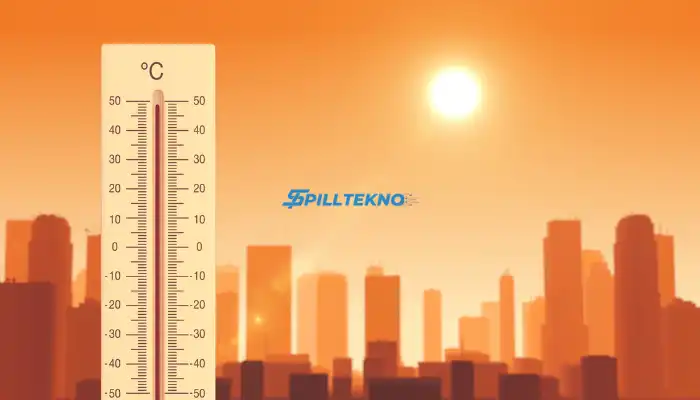Spilltekno – Spilltekno – Global warming is no longer a distant concern. The harsh reality is upon us, with climate models predicting that Earth’s temperature could rise by 2.7°C, nearly twice the 1.5°C limit set by the Paris Agreement.
This critical threshold was aimed at preventing catastrophic climate consequences, but the rapid pace of change is pushing us closer to an irreversible tipping point.
A recent report from the 2024 State of the Climate paints a grim picture. International scientists are closely tracking 35 vital signs of Earth, and this year, 25 of them have reached alarming record levels.
From shrinking sea ice to deforestation, the indicators are all pointing towards a future where humans may no longer thrive.
The Uninhabitable Future: Why 2.7°C Is a Death Sentence for Humanity
Human civilization has flourished over the past 10,000 years under relatively stable climate conditions. A slight rise in temperature can disrupt this delicate balance, with grave consequences for future generations. Extreme weather events are already reshaping our present, giving us a glimpse into what could become the norm.
Take, for instance, the intensifying tropical storms like Hurricane Helene in the Eastern United States and Super Typhoon Yagi in Vietnam. Both storms exhibited unprecedented strength, highlighting how warmer oceans are feeding more extreme weather.
In Brazil, historic droughts have turned mighty rivers into barren wastelands, drying up crucial water sources. Meanwhile, the heat in Mecca soared past 50°C during the annual Hajj, resulting in the tragic loss of over 1,300 pilgrims.
The Role of Fossil Fuels and Carbon Emissions in Global Warming
At the root of these devastating changes is our continued reliance on fossil fuels. Despite efforts to curb emissions, carbon dioxide levels in the atmosphere hit 418 ppm last September, and by this year, they surpassed 422 ppm. Methane, a greenhouse gas far more potent than CO₂, is also surging at an alarming rate.
Leading climate experts like Thomas Newsome from the University of Sydney and William Ripple from Oregon State University agree that urgent action is needed to prevent the world from heating up to the predicted 2.7°C.
They advocate for drastic reductions in fossil fuel consumption and significant reforestation efforts to combat climate change.
Mitigation Strategies: What Can We Do Now?
The pathway to slowing global warming lies in a multi-pronged approach:
- Reduce Fossil Fuel Dependence: The immediate priority is cutting down on fossil fuel use. This includes transitioning to renewable energy sources like solar, wind, and hydropower on a global scale.
- Reforestation and Fire Prevention: Increasing reforestation efforts while implementing better land-use policies to prevent deforestation and manage wildfires is critical. Protecting and restoring forests will help sequester carbon and lower atmospheric CO₂ levels.
- Global Cooperation and Financial Support: Wealthier nations must play a leading role by providing both financial and technical support to developing countries. Investment in renewable energy infrastructure, disaster preparedness programs, and sustainable land management practices can make a significant impact.
Why Immediate Action Matters: Avoiding the 2.7°C Catastrophe
If we continue on our current trajectory, Earth will warm by 2.7°C within this century. This level of heating is likely to trigger a series of irreversible changes, including the collapse of critical ecosystems and the extinction of countless species.
Rising sea levels could displace millions of people, while extreme weather events will become even more frequent and devastating.
To avoid reaching this tipping point, governments worldwide must strengthen their climate commitments. Reducing our dependence on fossil fuels and speeding up the transition to renewable energy is no longer optional—it’s a necessity.
FAQ
Q1: What is the Paris Agreement’s goal regarding global temperature rise?
The Paris Agreement aims to limit global temperature rise to 1.5°C above pre-industrial levels. However, current trends suggest we are on track to reach 2.7°C.
Q2: Why is a 2.7°C temperature rise so dangerous?
A 2.7°C rise could lead to irreversible damage to ecosystems, extreme weather events, rising sea levels, and the displacement of millions of people.
Q3: How can reforestation help combat climate change?
Reforestation helps by absorbing carbon dioxide from the atmosphere, reducing overall greenhouse gas levels, and mitigating global warming.
Q4: What role do wealthy countries play in the fight against climate change?
Wealthier nations have the resources to invest in renewable energy, provide financial aid to developing countries, and support disaster preparedness programs globally.
Q5: How can individuals contribute to reducing global warming?
Individuals can contribute by reducing energy consumption, using renewable energy sources, supporting policies that promote sustainability, and raising awareness about climate change.
There is still hope, but time is running out. Without bold and immediate changes, the 2.7°C rise in global temperatures will become an unavoidable reality, bringing unprecedented hardship to all of humanity. We must act now to ensure a livable future for the generations to come. Spilltekno
Check out other technology information at Google News Spilltekno
